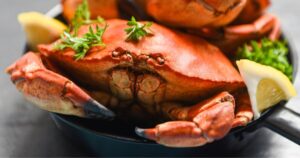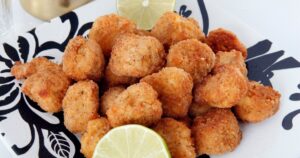Shrimp has a mild, buttery flavor that is slightly sweet and salty. The taste is unique, devoid of the intense fishy flavor that characterizes many types of seafood, making it a great choice for those new to seafood.
However, you must avoid eating shrimp if you have a shellfish allergy.
Whether you’re a seasoned shrimp lover or a curious home cook, this guide will provide a comprehensive understanding of what shrimp tastes like.
How Does Shrimp Taste?
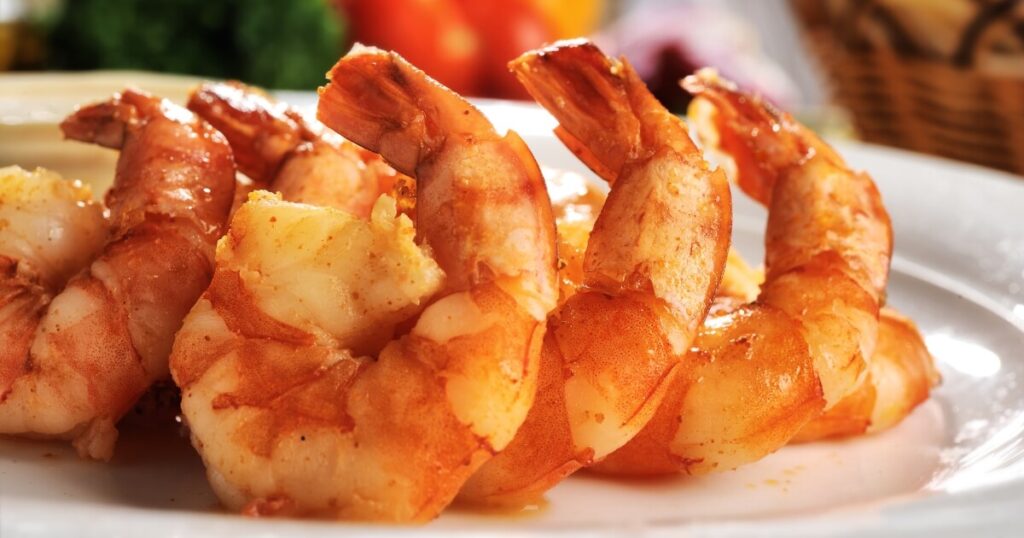
When describing shrimp’s taste, texture, and aroma, it’s important to consider several factors. Here’s a detailed breakdown:
Taste
Shrimp has a unique flavor that sets it apart from other types of seafood. It’s often described as having a mild, buttery taste that’s slightly sweet and salty.
Unlike stronger-tasting seafood, shrimp does not have an overpowering fishy flavor. Instead, its taste is subtle and pleasing, making it a versatile ingredient that can take on a variety of flavors in cooking.
Texture
The texture of shrimp is another aspect that contributes to its popularity. When cooked properly, shrimp has a firm yet tender texture. It’s not as hard as some shellfish, but it’s neither soft nor mushy.
The bite of a well-cooked shrimp is satisfyingly crunchy, adding a delightful contrast in dishes where it’s paired with softer ingredients.
Aroma
The aroma of shrimp is often overlooked, but it’s an integral part of the overall tasting experience. Fresh, raw shrimp has a clean, brine smell reminiscent of the ocean.
When it’s cooked, the aroma becomes more pronounced, releasing an enticing and delicious fragrant scent.
The aroma of cooked shrimp can often hint at its taste, with a buttery, slightly sweet smell indicating a well-prepared piece of shrimp.
Does Shrimp Taste Good?
The taste of shrimp is generally well-liked due to its mild, slightly sweet, and salty flavor. However, whether shrimp tastes good can be subjective and largely depends on individual preferences and how it’s prepared.
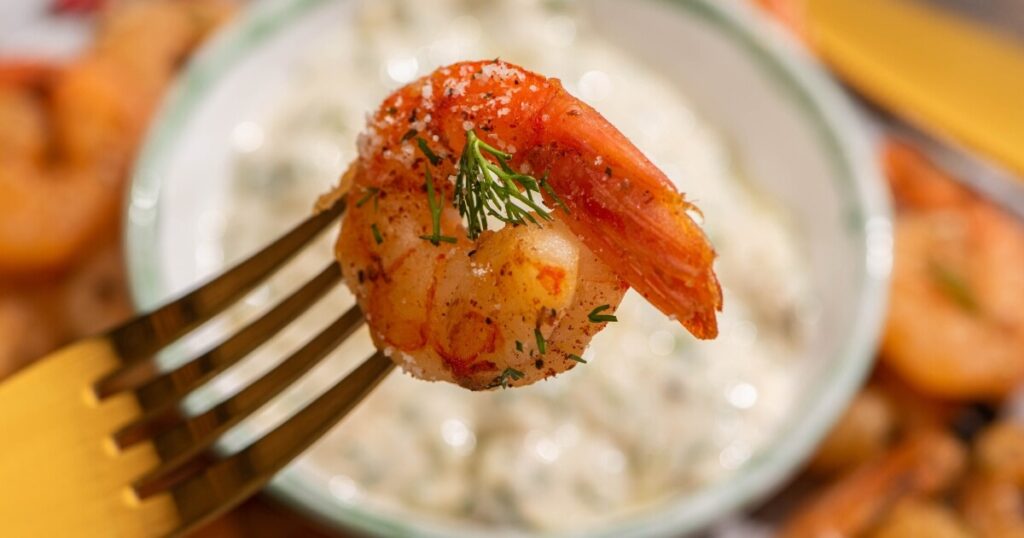
One common misconception about shrimp is that it has a strong, fishy flavor. This is usually not the case with fresh shrimp. Fresh shrimp has a clean, ocean-like taste that’s not overpoweringly fishy. If you encounter shrimp with a strong, unpleasant fishy smell or taste, it’s likely that the shrimp is not fresh.
Another factor that can influence the taste of shrimp is whether it’s fresh or frozen. Fresh shrimp often has a superior taste and texture compared to frozen shrimp. However, frozen shrimp can be enjoyable if properly thawed and cooked. The quality of frozen shrimp can vary, so it’s best to purchase from a reputable source.
There are also instances where shrimp might not taste as good, even if you generally enjoy it. Overcooking shrimp, for example, can result in a rubbery texture and a loss of its delicate buttery flavor. Similarly, undercooked shrimp can have a slimy texture that’s off-putting to many people.
In terms of preparation, shrimp can take on a variety of flavors based on the ingredients it’s cooked with. It can be delicious in a spicy curry, flavorful in a garlic butter sauce, or refreshing in a citrusy ceviche. The versatility of shrimp makes it a delightful ingredient to experiment with in the kitchen.
How to Make Shrimp Taste Better
Enhancing the taste of shrimp involves a combination of proper selection, preparation, and cooking techniques.
Here are some tips to make your shrimp taste even better:
- Choose Fresh or High-Quality Frozen Shrimp: Fresh shrimp often has the best flavor and texture. However, choose frozen shrimp from a reputable source if fresh shrimp isn’t available. Look for shrimp that’s been flash-frozen immediately after being caught to maintain its freshness.
- Proper Thawing: If you’re using frozen shrimp, thaw it properly to keep its flavor and texture. The best way to thaw shrimp is to place it in the refrigerator overnight. Avoid thawing shrimp at room temperature or under warm water, as it can lead to a loss of flavor and a rubbery texture.
- Marinate: Marinating shrimp can enhance its flavor. My goto is oil, lemon juice, garlic, and herbs. Remember not to marinate shrimp for too long, as acidic ingredients can start to cook the shrimp, leading to a mushy texture.
- Avoid Overcooking: Shrimp cooks quickly, and overcooking can result in a rubbery flesh and a loss of flavor. As a general rule, shrimp is done when it turns pink and forms a ‘C’ shape. If it forms an ‘O’ shape, it’s likely overcooked.
- Season Well: Don’t be shy with seasoning. Salt, pepper, and a squeeze of lemon can enhance the natural flavors of shrimp. For a spicy kick, consider adding a bit of chili powder or cayenne pepper.
- Pair with Complementary Flavors: Shrimp pairs well with a variety of flavors. Garlic, lemon, and herbs like parsley and dill are classic pairings. Try pairing shrimp with a glaze made from honey or maple syrup for a sweet and savory combination.
Whether you’re grilling, sautéing, or baking, these techniques will help you get the most flavor out of your shrimp.
What Does Shrimp Look Like?
When shopping for shrimp, knowing what to look for is important to ensure you’re getting a quality product.
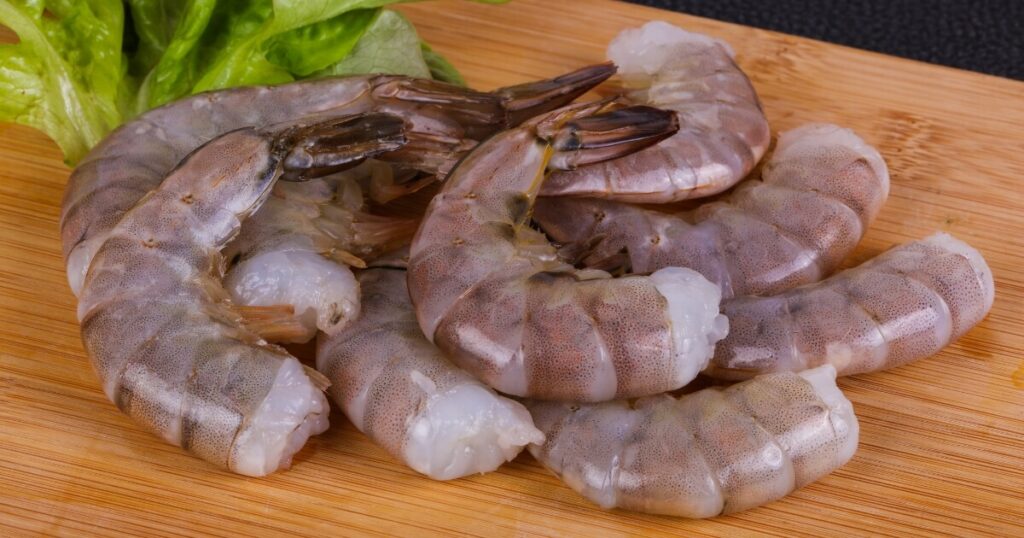
Here’s a detailed description of what shrimp looks like and how to identify it at the grocery store:
Size and Shape: Shrimp come in various sizes, from tiny to jumbo. Regardless of size, all shrimp have a similar shape. When cooked, they have a curved body that forms a ‘C’ shape. Shrimp also have a segmented body with a hard, translucent shell, and they are typically greyish-green or bluish in color when raw.
Color: Raw shrimp should have a clean, translucent look. The color can vary depending on the type of shrimp, but it’s usually a mix of grey, green, or blue. Cooked shrimp, on the other hand, turns a pinkish-orange color. If you notice any black spots or discoloration on the shrimp, it’s a sign of aging or poor handling.
Shell and Legs: Shrimp have a hard outer shell that covers their body and a series of legs underneath. The shell should be intact and not broken. Some shrimp are sold with the shell on, while others are sold with the shell removed.
Eyes: Fresh shrimp should have clear, bright eyes. The eyes are often a good indicator of freshness. If the eyes are missing or look dull, it’s likely that the shrimp is not fresh.
Smell: While not a visual indicator, the smell of shrimp is crucial in determining its quality. Fresh shrimp should have a mild, salty smell reminiscent of the sea. If it has a strong, unpleasant, or ammonia-like odor, it’s a sign that the shrimp is not fresh and should be avoided.
Is Shrimp A Meat Or Fish?
When it comes to classifying shrimp, there can be some confusion. Is it meat? Is it a fish? The answer lies in understanding the different food categories and how shrimp fits into them.
While shrimp might be referred to as a fish in casual conversation, and its nutritional profile is similar to that of meat, it’s technically neither fish nor meat. Shrimp is a crustacean, a unique category of delicious seafood that stands on its own.
In everyday conversation, many people tend to classify shrimp as a type of fish because it lives in the water and is often grouped with other seafood items on restaurant menus and in grocery stores.
However, from a biological perspective, shrimp is not a fish. Fish have a backbone, while shrimp are invertebrates, lacking a backbone.
Shrimp belong to a group of sea creatures known as crustaceans, including crabs, lobsters, and crayfish. Crustaceans are characterized by their hard exoskeleton and jointed appendages, features that distinguish them from fish.
On the other hand, referring to shrimp as meat can also be misleading. While the term “meat” is often used to refer to the flesh of animals, it’s typically associated with land animals like beef, pork, and poultry in culinary contexts. Shrimp, being a sea creature, doesn’t quite fit into this category either.
In dietary guidelines, shrimp is often categorized as a source of protein, similar to meats and fish. It’s a lean source of protein and provides a good amount of omega-3 fatty acids, much like fish.
Shrimp Taste Comparison With Similar Seafood
Lobster: Lobster is often considered a luxury seafood item, known for its rich, sweet, and slightly briny flavor. While shrimp also has a sweet and salty flavor profile, it’s typically milder than lobster. The texture of lobster is also firmer and meatier compared to the tender and slightly crunchy texture of shrimp.
Crab: Crab meat is sweet, delicate, and slightly buttery, somewhat similar to shrimp. However, crab tends to have a more pronounced sweetness compared to shrimp. In terms of texture, crab meat is flaky and tender, while shrimp is firmer.
Prawns: Prawns and shrimp are often confused due to their similar appearance. They have a similar flavor profile—mild, sweet, and slightly salty. However, prawns are often described as slightly sweeter and meatier than shrimp. The texture of prawns is also slightly firmer than shrimp.
Scallops: Scallops have a unique sweet, rich flavor that’s different from shrimp. They taste like the sea but in a mild, sweet way. The texture of scallops is also different—they’re more tender and less crunchy compared to shrimp.
Clams: Clams have a stronger, brinier flavor compared to shrimp. They also have a chewier texture. Shrimp, with its milder, sweeter flavor and tender texture, can be a more approachable seafood option for those who find the taste of clams too strong.
Recipes And Side Dishes With Shrimp
Here are some popular recipes where shrimp takes center stage, as well as some side dishes that pair well with it:
Shrimp Recipes
- Shrimp Scampi: This classic Italian-American dish features shrimp sautéed in a delicious sauce made from garlic, butter, lemon juice, and white wine. It’s typically served over pasta and garnished with fresh parsley.
- Shrimp Stir-Fry: Shrimp can be quickly cooked in a hot pan with various vegetables and a flavorful sauce. Common additions include bell peppers, broccoli, and snap peas. The sauce can be as simple as soy sauce and sesame oil or more complex with the addition of ingredients like ginger, garlic, and chili paste.
- Grilled Shrimp: Shrimp takes well to grilling. Marinate your shrimp, then skewer and grill them until they’re pink and slightly charred.
- Shrimp Tacos: For a Mexican twist, try making shrimp tacos. Season the shrimp with chili powder, cumin, and garlic, then cook until they’re finished. Serve them in a soft tortilla with a tangy slaw and a dollop of creamy avocado sauce.
Side Dishes for Shrimp
- Rice: Whether it’s plain steamed rice, a vibrant pilaf, or a rich risotto, rice is a great side dish for shrimp. It’s a neutral base that can soak up any delicious sauces from the shrimp dish.
- Salad: A fresh, crisp salad can contrast the rich, buttery flavor of shrimp. A quick salad with a tangy vinaigrette works well, or for something a bit different, try a tangy coleslaw or a fresh corn salad.
- Bread: A crusty baguette or garlic bread is perfect for mopping up any delicious sauces in a shrimp dish. If you’re serving shrimp scampi, bread is a must-have side.
- Roasted Vegetables: Roasted vegetables are hearty and stand up to shrimp. Try roasting your favorite vegetables—bell peppers, zucchini, and cherry tomatoes—with some olive oil, salt, and pepper.
My Tasty Thoughts
Whether grilling it for a summer barbecue, tossing it in a stir-fry, or adding it to a comforting pasta dish, shrimp brings a unique and delicious taste to the table.
However, like any food, whether you enjoy shrimp depends on personal preference. Some people might find its flavor too subtle, while its texture might put others off. But for those who enjoy seafood, shrimp is a must-try. Its delicate flavor and satisfying bite make it a crowd-pleaser in many culinary traditions around the world.
If you’re new to shrimp, I’d recommend starting with a simple dish like shrimp scampi or grilled shrimp. These dishes allow the natural flavor of shrimp to shine through. And remember, the key to delicious shrimp is in the quality and freshness of the shrimp you choose, as well as not overcooking it.

